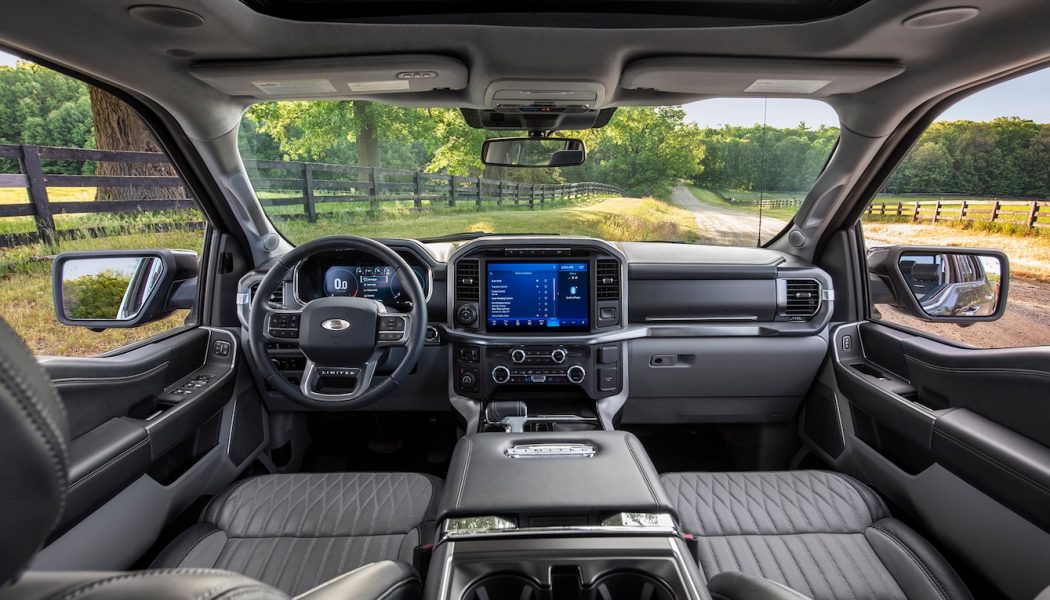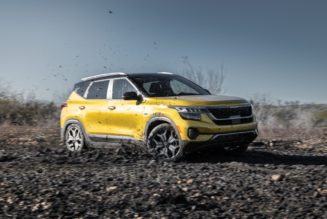Trivia numerologists: We’ve got the numbers, facts and figures that will guarantee your team a big win should a 2021 Ford F-150 round come up on your next Zoom Trivia session.
1,000/18,000/600—These are market research stats Ford racked up while planning the improvements to the 2021 F-150: 1,000 hours spent with customers taking 18,000 photos and 600 hours of video of them working with their trucks. This helped Ford’s team decide what to keep, what to refine, and where to innovate.
33.3—The percentage of customers who regularly use a laptop in the cab of their F-150. Some even engineered their own elaborate laptop stands, but Ford simplifies their life this year with the power-folding console shifter that allows the center armrest to flip over and form a perfectly flat surface on which to place a laptop, serve lunch, sign checks, whatever. Note that bench seat models provide a slide-out extension to the folded center seatback that emulates the same feature.
92—The percentage of new part numbers in the 2021 F-150. We must assume that the carryover engines and transmissions count as one part number each, and some parts—like the windshield and roof—get new numbers because while they’re shaped the same, they’re modified to accept new driver-assistance features and antenna mounts. But most of what you see and touch is newer than it may appear at first glance.
1.5 at 35—These are the energy and power specs for the Power Boost hybrid’s briefcase-sized, frame-mounted battery pack: 1.5 kWh of energy that can be dispensed at a maximum rate of 35 kW (matching the peak output of the electric motor mounted between the engine and transmission).
2.0/2.4/7.2 on 75—These are the three available kilowatt outputs of the F-150’s Pro Power onboard generator, providing 110-volt power in the bed at 15 or 20 amps, or 220-volt power at up to 30 amps. Gasoline models can only get the 2.0-kW version; hybrid Power Boost F-150s get 2.4-kW generation standard, while 7.2-kW is optional. Pro Power will be available on 75 percent of F-150s (all but the 3.3-liter and the diesel). Note, the in-cabin 110-volt plug retains its lowly 400-watt inverter on all. In all models, it cycles the engine on and off automatically as necessary to provide the power being drawn.
6—The total number of trim grades drops by one, as the Raptor will not be available from the outset on the 2021 F-150 but will return later. The walk starts with XL (on which an STX appearance package will be offered with 18-inch aluminum wheels). XLT is next, with chrome and sport appearance offerings getting bumper, mirror caps, and accents in either chrome or body color. Lariat is also offered with chrome or sport appearance but adds leather and more goodies. From there, the offerings step up through King Ranch, Platinum, and Limited. An FX4 off-road package is available throughout the lineup.
11 from 5—The 2021 F-150 will be available with 11 different grille designs, created from 5 different molds; one gets 4 different finishes, one gets 3, one gets 2, and two are unique.
13 of 12—For 2021, 13 wheel offerings will be produced from 12 designs. The most basic 17-inch wheel is steel; two 18-inch alloy options share the same mold with different finishes, the rest are unique, stepping up in size to a maximum of 22 inches.
3 Cs—Three different headlamp offerings use halogen, LED reflector, and LED projector technology. The latter version on top models animates the beams to follow the steering. A C-clamp appearance created by accent LED outline of the main lamp and the fog lamp below helps identify all F-150s from a distance.
10/10/80—Percentage of expected powertrain sales mix: 10 percent Power Boost hybrid, 10 percent base 3.3-liter V-6, 80 percent EcoBoost, Power Stroke diesel, and 5.0 V-8 (note that for 2020, EcoBoost accounted for 60 percent of the mix)
8-18—The speaker count in F-150s ranges from the 8 speakers in the base truck to an upgraded B&O Play that also features 8 speakers. True audiophiles will opt for an 18-speaker B&O Play system that incorporates speakers in the front headrests and in the headliner.
58-70 or 78-90/40-45/3—Aerodynamic improvements include an active air dam that deploys to reduce drag inducing airflow under the truck. Its shape protrudes lower in the corners than in the middle, dropping 58mm in the center and 70mm in the corners of the rear-drive models; 78mm in the center and 90 mm in the corners of the 4x4s. The dam deploys between 40 and 45 mph. Combined with the carryover grille shutters and revised shapes of the C-pillars and tailgate “spoiler” top, they improve aerodynamics by 3 percent.
810 to 840—Mainstream model outside tire diameters increase from 810 to 840mm (32 to 33 inches) to reduce the appearance of “air over the tire” in the wheel wells. But the engineers “re-gridded” the suspension (adjusted settings) to maintain carryover ground clearance and height. Note that base 17- and 18-inch wheel fitments carry over with smaller outside diameter.










